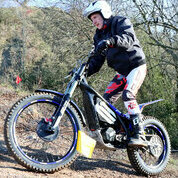-
Posts
1,177 -
Joined
-
Last visited
Contact Information
-
I finally solved the problem with great help from Inch Perfect Trials. It was a fault in the wiring loom. I changed the loom and all is now well. Once I have done a full trial or a practice day I'll do an autopsy on the old look to see if I can pin down exactly where the fault is. With the plastics and all the cable ties off, I did find that wiggling around all the wires at the back-end would very occasionally solve the problem, but then a minor touch and it would come back. Also the symptoms changed; from beep-beep whatever the throttle position to no beep and no ability to engage a map.
-
Sport80 is a generic sports administration system that the ACU has been using for a couple of years. I'm not sure if it has inherent flaws or is simply badly implemented in the motorcycle sport environment, but at least it's not as bad as when it started. Pre-entry of trials is normally done through Sport80, though it doesn't have to be. Some ACU clubs stick with entry on the day and some use this simpler and easier alternative system: https://mototrial.co.uk/trial-entry/ AMCA clubs are generally enter-on-the-day, but occasionally use their own system or the Mototrial one. As Lemur said, pre-entry is much better for the organising clubs (Sport80 notwithstanding!) but enter-on-the-day is preferred by casual riders who can decide at the last minute whether to ride or not.
-
Two very good points that I had forgotten.
-
Gear oil is crucial with the Beta clutch. When I had one I found that Putoline Nano-trans gave me the best clutch feel and progression.
-
Last weekend threw up a problem on my 2023 ePure Race. After about 2 hours of practice riding I returned to my car and parked up. A few minutes later I was going to take the lazy way out and ride the bike round in a circle to load up. However I couldn't, because every time I attached the lanyard I got the beeps that say "You've got some throttle on so I'm not going to let you select a map." I fiddled with the lanyard and the throttle, switched off and on, but nothing solved it so I pushed the bike. At least I was lucky it didn't do it at the far end of the site which would have left me with a 1 mile uphill push 😱.So today I have dug into things further. I tried switching to the training throttle connection (T1/T2. I've now forgotten which is which so that will be another small problem when I come to put things back together.). Same problem. I took the throttle apart to make sure the potentiometer was fully back against the stop. It was, and still the same problem. I'm struggling to see what my next logical step should be. I don't want to just be randomly changing parts until something works. Any ideas, anyone?
-
I just wanted to give a shout-out for Custom Hoses (customhouses.co.uk). I ordered a special brake hose at lunchtime on Friday. It was made on Friday afternoon and delivered by Royal Mail on Saturday morning. No connection except as a very satisfied customer.
-
Talon was super-expensive plus 8 weeks delivery! In the end I found Adam Hodson (oneoffsprox@gmail.com) who made me one for a reasonable price and about 1 week delivery. I rode the bike for about an hour and very pleased with the change; it's taken the fire out of the blue map and made it much more usable (for me!) yet the green map doesn't feel noticeably more sluggish.
-
Trials is a niche sport so it's unrealistic to think that dealers can hold a stock of everything. Especially something like clothing with the vast number of permutations of style, colour and size. If they can get something in and then dispatch it to you in a few days, I think that's generally fair enough.
-
I used to see Jon at trials in the Cotswolds (of course!) but I've not seen him for at least a year. Maybe he's retired from trials stuff.
-
Welcome ukbta. Where do you live? You may find there's someone on here that is close to you. It will also help us guide you on questions like dealers, practice areas, etc.
-
The project continues to move forward very slowly. I made up a little jump loom and fitted it in the Y-piece in place of the FRB. It seems to work but I used a potentiometer with about 3/4 turn from max to min and it is super-sensitive so not useable as it stands. I've got to look again to find a multi-turn pot that is solderable and will package nicely.
-
I haven't contacted Talon but followed the link from ChrisCH to motorcycleraceparts.
-
I did calculate all the permutations, though I've lost them now. Going up one tooth on the front would also give suitable gearing but space is tight. I think it would fit but it would require the chain to be threaded on to the sprocket rather than just looped on sideways (and turning the sprocket by hand is extremely hard). I'm hoping a custom-made sprocket will be the way to go, which I think will cost about £30-£40 more than an off-the-shelf.
-
I bought the first one from Splat Shop. They have been very helpful in trying to find me another, but no success.
-
I had a really good feel for my old (2021) bike with a 51T sprocket on it. Foolishly I left it on when I changed the bike, thinking it would be easy enough to get another one for my new (2023) bike. It's not. I can't find one anywhere. Does anyone one have one to sell, or know where I could get one? 51T preferred but I would go with 50T or 52T too.




